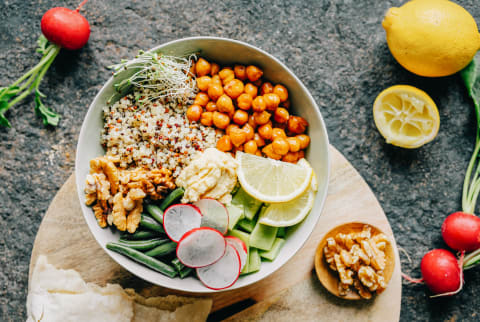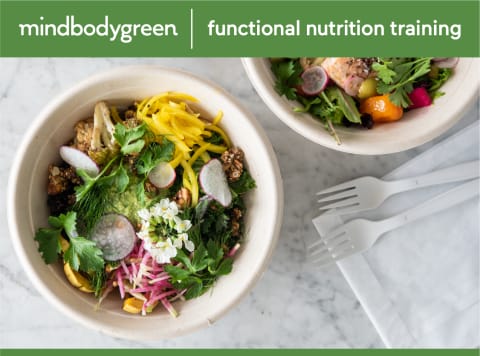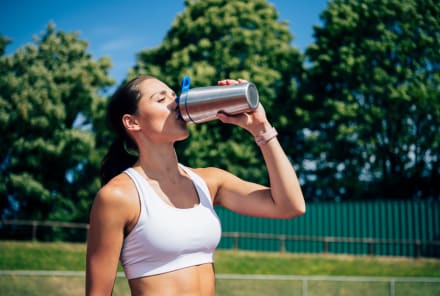Advertisement
7 Nutrients You May Be Missing On A Plant-Based Diet + A Gut Specialist's Favorite Sources


What does the ultimate gut-health diet look like? The truth is, there is no single gut-health diet.
There are, however, guiding principles that underpin an eating pattern that supports good gut health. If you only take one thing away, this is it: The power of plant diversity is key, and the more the merrier. What this looks like in terms of final foods is really up to you, your preferences, and where you are on your gut health journey.
This same concept is observed within the Blue Zones: five regions around the world where people live particularly long and healthy lives. Despite sharing several fundamental principles, including a focus on plant-based foods, many aspects of their diet, including intake of dairy and meat, are inconsistent, with some zones including them and others not.
This reinforces the fact that there is no single "right" way to eat. That said, if you are cutting out entire food groups, you're naturally at an increased risk of a nutritional deficiency. Rest assured: It is possible to get all the nutrients you need from other foods.
7 nutrients to consider if you're eating a purely plant-based diet:
Calcium
Dairy foods are rich in calcium. If you're not eating these, choose calcium-fortified plant-based milks. Other sources include tofu (check on the label that it's set with calcium chloride or calcium sulfate), and spring greens. Keep in mind that, although spinach contains calcium, it's mostly bound to a compound called oxalate, which limits its absorption.
Iodine
Seafood is a good source of iodine. If you don't eat seafood, you may like to consider including sea vegetables in your diet. While plant-based foods such as cereals and grains can be a source of iodine, the levels vary depending on the amount of iodine in the soil where the plants were grown.
Iron
The iron found in plants (nonheme iron) is less efficiently absorbed. To help your body absorb iron from plant foods, include a source of vitamin C with your meals. These include tomatoes, peppers, oranges, and strawberries.
Omega-3 fats
Most of the health benefits of omega-3 have been linked to animal-based sources (docosahexaenoic acid, or DHA, and eicosapentaenoic acid, or EPA). The plant-based type of omega-3 (alpha-linolenic acid, or ALA) can be converted by our bodies into DHA and EPA. But the conversion is not efficient, which is why, if you're vegan, it's important to include plenty of the plant-based sources and consider fortified foods or supplements.
Selenium
Meat, fish, and nuts are good sources of selenium. If you're purely plant-based, it's best to include nuts in your diet. Brazil nuts top the selenium charts.
Vitamin B12
Eggs and dairy are good sources of B12. If you're vegan, consider foods fortified with B12, including fortified plant-based milks and yogurts. Nutritional yeast is another source, which I commonly use in cooking for its cheesy flavor profile.
Zinc
Phytates found in plant foods such as whole grains and legumes can reduce zinc absorption. Fermenting and sprouting can help reduce the amount of phytates in these foods. Nuts and seeds are also good sources.
Watch Next
Enjoy some of our favorite clips from classes
Enjoy some of our favorite clips from classes
What Is Meditation?
Mindfulness/Spirituality | Light Watkins
Box Breathing
Mindfulness/Spirituality | Gwen Dittmar
What Breathwork Can Address
Mindfulness/Spirituality | Gwen Dittmar
The 8 Limbs of Yoga - What is Asana?
Yoga | Caley Alyssa
Two Standing Postures to Open Up Tight Hips
Yoga | Caley Alyssa
How Plants Can Optimize Athletic Performance
Nutrition | Rich Roll
What to Eat Before a Workout
Nutrition | Rich Roll
How Ayurveda Helps Us Navigate Modern Life
Nutrition | Sahara Rose
Messages About Love & Relationships
Love & Relationships | Esther Perel
Love Languages
Love & Relationships | Esther Perel


















